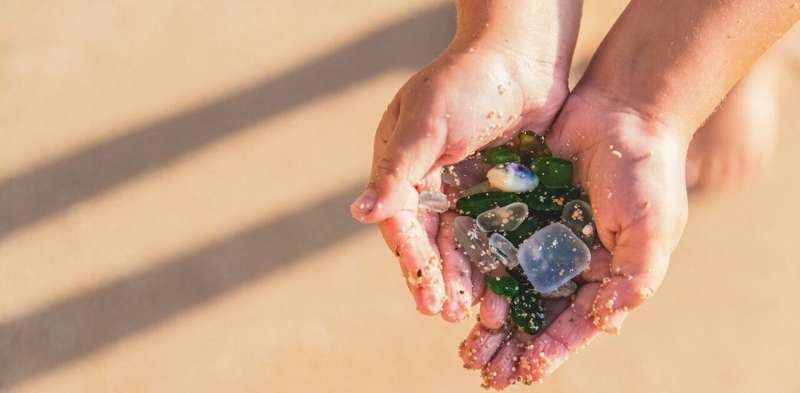This article has been reviewed according to Science X's editorial process and policies. Editors have highlighted the following attributes while ensuring the content's credibility:
fact-checked
trusted source
written by researcher(s)
proofread
Sea glass, a treasure formed from trash, is on the decline as single-use plastic takes over

When you stroll along a beach, you may look down and spot colorful bits of worn glass mixed in with the sand. But the little treasures you've found actually began as discarded trash.
As an environmental science professor, I find these gifts from the sea particularly interesting. I have analyzed sand from across the world and added samples, including one of sea glass, into a collection for the environmental, earth and atmospheric sciences at UMass Lowell. The way this trash-turned-treasure washes up on beaches reflects an intersection between human activity and Earth's natural processes.
A history of glass
Prior to the proliferation of single-use plastics starting in the early 1970s, glass was the container of choice. People in ancient Egypt, Greece and Rome used glass for windows, bottles, plates, bowls and more.
In the mid-20th century, people across the United States had milk bottles delivered to their homes, and soda came in glass bottles. After these glass containers served their purpose, users would toss them into a dump.
Before the environmental movements of the 1960s, trash dumps in the United States were often left open and exposed to rain and wind. As many of these trash heaps sat near waterways or coves, runoff would wash the trash—including discarded glass bottles—into the ocean.
On their way to the ocean, glass bottles would run into rocks and other objects, which would break the glass into smaller pieces. When these fractured bits traveled close enough to the coast, high tides and incoming waves would wash them out to sea.
Wave action causes these fragments to slide and roll along the sandy seafloor. It's this movement that rounds the glass' sharp edges and gives the once smooth and clear glass its pitted, frosted appearance.
Sand to glass, then back to the sand
All glass, including sea glass, begins as sand, specifically quartz sand. Quartz sand is clear or white—you can see it on many beaches along Florida's Gulf Coast.
To make glass from sand, refiners first purify their quartz sand using both physical and chemical processes to remove all minerals but quartz. They then melt the remaining quartz sand, add a bit of soda ash and limestone to increase the malleability and strength of the glass, and reform it into bottles, bowls, windows and more.
Because quartz is the foundation of all glass, many of the mineral's characteristics are reflected in sea glass. The most obvious is its clarity—quartz is nearly translucent—but also how quartz fractures or breaks. Quartz fractures tend to be a special type of break, called a conchoidal fracture. This type of fracture begins from a single point and breaks outwardly in a semicircular shape, so that the broken surface kind of looks like the inside of a seashell.
Quartz is also highly resistant to chemical weathering. Because sea glass is made from quartz, it tends to break down into smaller fragments, but it won't weather away quickly.
Most sea glass spends at least a few decades on the seafloor getting tossed around and smoothing its sharp edges in the sand. Some pieces of sea glass are estimated to be hundreds of years old—it's quartz's hardiness that allows sea glass to persist in the environment for such a long time.
A global industry
Selling and trading sea glass is a multimillion-dollar industry in the United States, supported by organizations like the North American Sea Glass Association and the International Sea Glass Association.
Sea glass jewelry and collections populate craft shows all around the country. There are likely very few beach towns in the United States without a local sea glass jeweler selling custom designs.
With the explosion of single-use plastics as an alternative to glass bottles, sea glass may soon become harder to find, with less glass and more plastic in the supply chain.
As sea glass becomes harder to find, some retailers are creating their own artificial sea glass using rock tumblers and chemicals. The difference between the real and artificial beach glass is subtle but still recognizable. Artificial sea glass has a uniformly frosted exterior, without the pitting seen in natural sea glass.
The public may eventually become less interested in single-use items and turn back to glass. Unlike plastic, glass can be recycled multiple times without losing its integrity, and glass doesn't have the same environmental impact as microplastics.
But because there aren't many markets for recycled glass and it's heavy and difficult to transport, it's not always financially beneficial to recycle glass.
However, activists have demanded environmentally friendly alternatives to single-use plastics in recent years. Aluminum bottles and cans are becoming more popular, and glass will remain an alternative to plastic. Unless it's properly recycled, discarded glass will continue providing sea glass for the next generations to discover.
Provided by The Conversation
This article is republished from The Conversation under a Creative Commons license. Read the original article.![]()




















